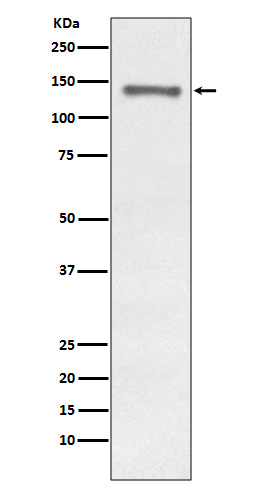Raptor Antibody
Rabbit mAb
- 产品详情
- 实验流程
Application
| WB, IHC, IF, FC, ICC, IP, IHF |
|---|---|
| Primary Accession | Q8N122 |
| Reactivity | Rat, Human, Mouse |
| Clonality | Monoclonal |
| Other Names | RPTOR; KOG1; KIAA1303; RAPTOR; Mip1; |
| Isotype | Rabbit IgG |
| Host | Rabbit |
| Calculated MW | 149038 Da |
| Dilution | WB 1:500~1:1000 IHC 1:50~1:100 ICC/IF 1:50~1:100 IP 1:30 FC 1:30 |
|---|---|
| Purification | Affinity-chromatography |
| Immunogen | A synthesized peptide derived from human Raptor |
| Description | The regulatory associated protein of mTOR (Raptor) was identified as an mTOR binding partner that mediates mTOR signaling to downstream targets. Raptor binds to mTOR substrates, including 4E-BP1 and p70 S6 kinase, through their TOR signaling (TOS) motifs and is required for mTOR-mediated phosphorylation of these substrates. Binding of the FKBP12-rapamycin complex to mTOR inhibits the mTOR-raptor interaction, suggesting a mechanism for rapamycin's specific inhibition of mTOR signaling. This mTOR-raptor interaction and its regulation by nutrients and/or rapamycin is dependent on a protein called GβL. |
| Storage Condition and Buffer | Rabbit IgG in phosphate buffered saline , pH 7.4, 150mM NaCl, 0.02% sodium azide and 50% glycerol. Store at +4°C short term. Store at -20°C long term. Avoid freeze / thaw cycle. |
| Name | RPTOR (HGNC:30287) |
|---|---|
| Function | Component of the mechanistic target of rapamycin complex 1 (mTORC1), an evolutionarily conserved central nutrient sensor that stimulates anabolic reactions and macromolecule biosynthesis to promote cellular biomass generation and growth (PubMed:12150925, PubMed:12150926, PubMed:12747827, PubMed:24403073, PubMed:26588989, PubMed:32561715, PubMed:37541260). In response to nutrients, growth factors or amino acids, mTORC1 is recruited to the lysosome membrane and promotes protein, lipid and nucleotide synthesis by phosphorylating several substrates, such as ribosomal protein S6 kinase (RPS6KB1 and RPS6KB2) and EIF4EBP1 (4E-BP1) (PubMed:12150925, PubMed:12150926, PubMed:12747827, PubMed:24403073, PubMed:26588989, PubMed:37541260). In the same time, it inhibits catabolic pathways by phosphorylating the autophagy initiation components ULK1 and ATG13, as well as transcription factor TFEB, a master regulators of lysosomal biogenesis and autophagy (PubMed:12150925, PubMed:12150926, PubMed:12747827, PubMed:24403073, PubMed:32561715, PubMed:37541260). The mTORC1 complex is inhibited in response to starvation and amino acid depletion (PubMed:12150925, PubMed:12150926, PubMed:12747827, PubMed:24403073, PubMed:37541260). Within the mTORC1 complex, RPTOR acts both as a molecular adapter, which (1) mediates recruitment of mTORC1 to lysosomal membranes via interaction with small GTPases Rag (RagA/RRAGA, RagB/RRAGB, RagC/RRAGC and/or RagD/RRAGD), and a (2) substrate-specific adapter, which promotes substrate specificity by binding to TOS motif- containing proteins and direct them towards the active site of the MTOR kinase domain for phosphorylation (PubMed:12747827, PubMed:24403073, PubMed:26588989, PubMed:37541260). mTORC1 complex regulates many cellular processes, such as odontoblast and osteoclast differentiation or neuronal transmission (By similarity). mTORC1 complex in excitatory neuronal transmission is required for the prosocial behavior induced by the psychoactive substance lysergic acid diethylamide (LSD) (By similarity). |
| Cellular Location | Lysosome membrane. Cytoplasm Cytoplasmic granule. Note=Targeting to lysosomes depends on amino acid availability: recruited to lysosome membranes via interaction with GTP-bound form of RagA/RRAGA (or RagB/RRAGB) in complex with the GDP-bound form of RagC/RRAGC (or RagD/RRAGD), promoting recruitment of mTORC1 to the lysosomes (PubMed:31601708, PubMed:31601764). In arsenite-stressed cells, accumulates in stress granules when associated with SPAG5 and association with lysosomes is drastically decreased (PubMed:23953116). |
| Tissue Location | Highly expressed in skeletal muscle, and in a lesser extent in brain, lung, small intestine, kidney and placenta |
Research Areas
For Research Use Only. Not For Use In Diagnostic Procedures.
Application Protocols
Provided below are standard protocols that you may find useful for product applications.
终于等到您。ABCEPTA(百远生物)抗体产品。
点击下方“我要评价 ”按钮提交您的反馈信息,您的反馈和评价是我们最宝贵的财富之一,
我们将在1-3个工作日内处理您的反馈信息。
如有疑问,联系:0512-88856768 tech-china@abcepta.com.
¥ 1,500.00
Cat# AP90602























 癌症的基本特征包括细胞增殖、血管生成、迁移、凋亡逃避机制和细胞永生等。找到癌症发生过程中这些通路的关键标记物和对应的抗体用于检测至关重要。
癌症的基本特征包括细胞增殖、血管生成、迁移、凋亡逃避机制和细胞永生等。找到癌症发生过程中这些通路的关键标记物和对应的抗体用于检测至关重要。 为您推荐一个泛素化位点预测神器——泛素化分析工具,可以为您的蛋白的泛素化位点作出预测和评分。
为您推荐一个泛素化位点预测神器——泛素化分析工具,可以为您的蛋白的泛素化位点作出预测和评分。 细胞自噬受体图形绘图工具为你的蛋白的细胞受体结合位点作出预测和评分,识别结合到自噬通路中的蛋白是非常重要的,便于让我们理解自噬在正常生理、病理过程中的作用,如发育、细胞分化、神经退化性疾病、压力条件下、感染和癌症。
细胞自噬受体图形绘图工具为你的蛋白的细胞受体结合位点作出预测和评分,识别结合到自噬通路中的蛋白是非常重要的,便于让我们理解自噬在正常生理、病理过程中的作用,如发育、细胞分化、神经退化性疾病、压力条件下、感染和癌症。






